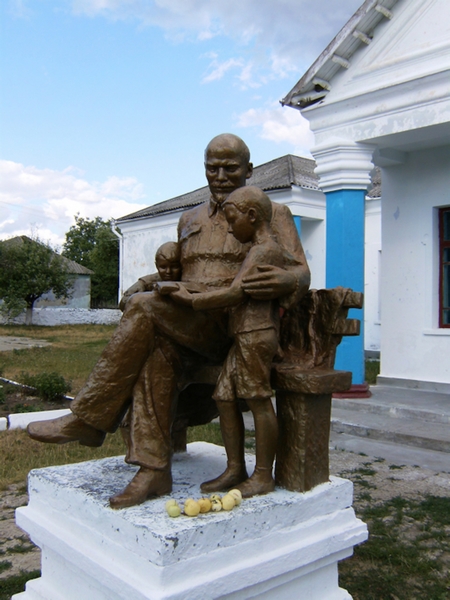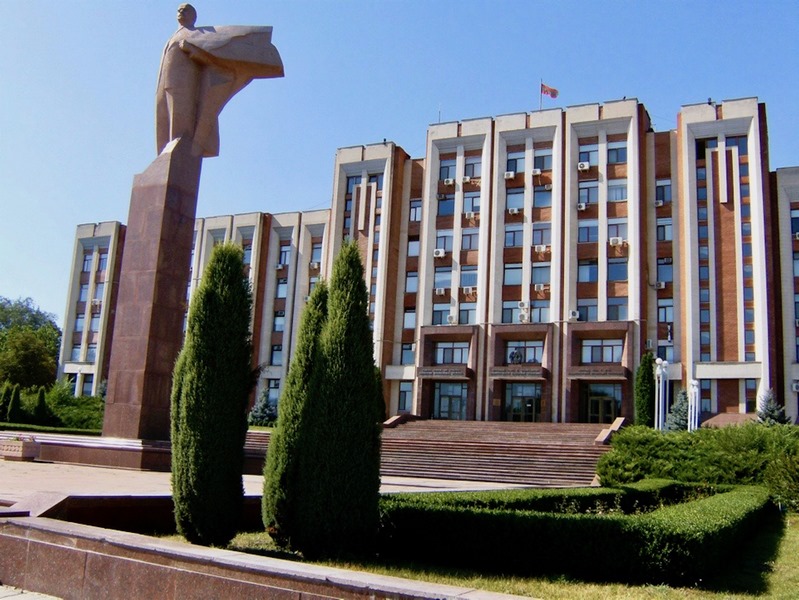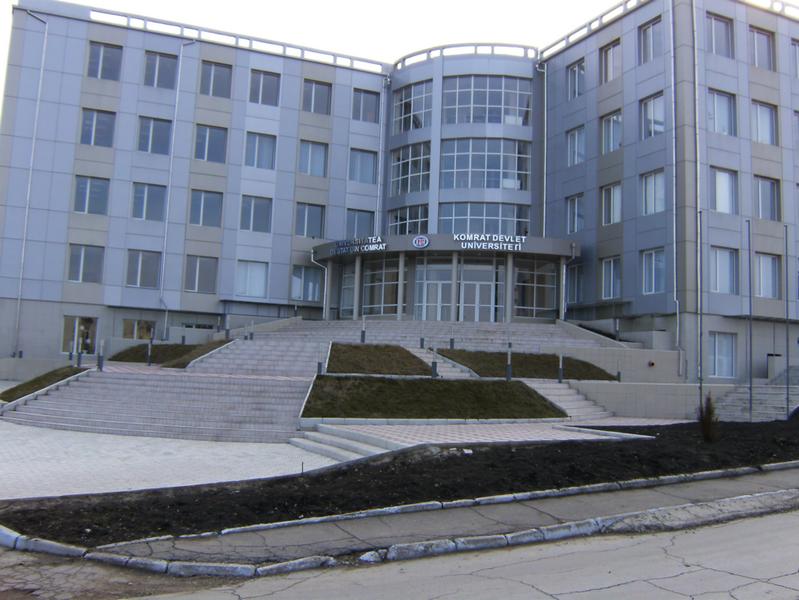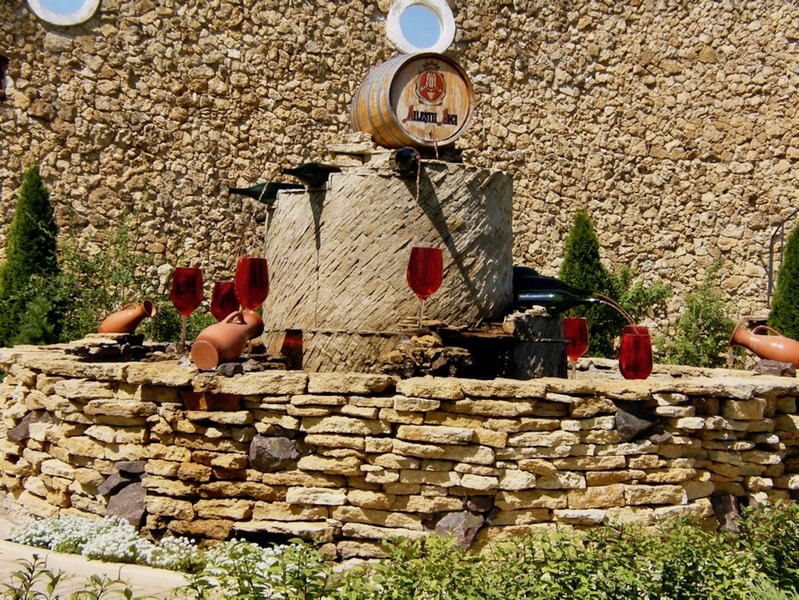THE WARSAW INSTITUTE REVIEW
Date: 9 July 2018 Author: Robert Rajczyk, PhD
Moldova – The Land of Miracles
Moldova is a small country with enormous problems. For 25 years of statehood, the country has continued to be one of the fronts in the struggle for dominance in the post-Soviet area.
 A statue of Vladimir Lenin reading to children. © Author’s personal archive
A statue of Vladimir Lenin reading to children. © Author’s personal archiveThe Republic of Moldova is a small country situated between Romania and Ukraine. Little known in Europe, it impresses with its pristine nature, a few tourist attractions, a unique history and an even more intriguing present. A country of fewer than three million inhabitants, it is a place where the pro-Western struggles with the pro-Russian. This is also a place where one man pulls all the strings – the country’s wealthiest oligarch, and the so-called “puppet master”. Vlad Plahotniuc, nominally a MP and head of the largest parliamentary party, performs on three stages – each of which playing out its own drama. The action in these performances is sometimes related, but most often the individual acts are characterized by their own dramaturgy.
Moldova is a country with three factual political entities, more or less dependent on each other.
Contemporary Moldova refers to the historical heritage of the Moldovan principality, although this is a massive simplification due to the changes in its territorial range and the lack of continuity of the state and law between the then principality and today’s Moldova. In 1812, as a result of a peace agreement between the Russian Empire and the Ottoman Empire, the eastern part of the Moldovan principality became part of Russia. This area, located between the Prut River and the Dniester River, has since been called the Bessarabia Governorate (Bessarabia), the name of which probably comes from that of the medieval ruler of Wallachia.
The other part of Moldova created in 1859 a personal union with the principality of Wallachia to form the Romanian United Principalities on January 24, 1862.
Today’s Moldova is, therefore, not only the sovereign Republic of Moldova, but also the name of a geographical-historical region in Romania. On 27 March 1918, the local parliament, the Country Council, passed a resolution on the inclusion of Bessarabia into the Kingdom of Romania. In 1924, the USSR, which filed territorial claims against Romania, established the Moldovan Autonomous Soviet Socialist Republic as part of the Ukrainian Soviet Socialist Republic, out of land that had never been part of the principality of Moldavia, east of the Dniester River. According to Bartłomiej Zdaniuk, it was to be “a political forerunner of Soviet power, preparing for the future takeover of Bessarabia.” In 1940, the Soviet Union annexed Bessarabia, implementing the provisions of the Ribbentrop-Molotov Agreement. Its central part was connected with the Moldovan Autonomous SRR located on the left bank of the Dniester River, and transformed into the Moldovan SRR – one of the 15 republics of the Soviet Union. The northern and southern parts of Bessarabia were included in the Ukrainian SRR. Therefore, in political and legal terms and in terms of state tradition, the present-day Republic of Moldova’s historical roots are not so much in the Principality of Moldova as much as they are in the heritage of the Bessarabia Governorate, but above all, in Soviet Moldova.
The Republic of Moldova proclaimed its independence on 27 August 1991. However, it is probably the one of only a few, if not the only, example in the world where the idea of state sovereignty is connected with the unification with a larger neighbor. In the 1980s, a social movement called Popular Front, which was anti-communist with the aim of uniting with Romania, was established.
Miracle 1: Moldovan Language
In Moldova language has become the foundation of statehood – not of a nation in an ethnic sense, but in its statehood. On the wave of Gorbachev’s perestroika, the republican separatist movements began to emancipate. Victor Suvorov in his famous book
Aquarium describes such a case as an example of training Soviet saboteurs. Suvorov gets a task from a superior in military intelligence to make an inscription in Moldovan on the wall of the Pedagogical Institute in Chișinău. The problem is that Moldovan is, in fact, Romanian, but with borrowings from Russian. During the Soviet era, Moldovan was written in Cyrillic, and local nationalists demanded the restoration of the Latin alphabet. Incidentally, Moldovan still functions in the Transnistrian Republic of Moldova in the form of civil script.
In December 2013, the Moldovan constitutional court issued a verdict on the state language. The judges ruled that the official language was Romanian, as stipulated in the Declaration of Independence, and not Moldovan in the form of Latin alphabet, as stated in the constitution, which means that the Declaration of Independence takes precedence over the constitution. On a side note, in 2007 a Moldovan-Romanian dictionary by Vasile Stati was published, and a subject called Romanian started to be taught in schools. What is more, when communists exercised political power in Moldova, they described the state language (limba de stat) as Moldovan, while pro-European groups use the phrase: Romanian language.
Miracle 2: Moldoveni deci Români (Moldovans i.e. Romanians)
Dissolution with the idea of unification took place for more than 20 years starting from the beginning of the 1990s. The people of the Republic of Moldova voted overwhelmingly in favor of maintaining national sovereignty in a national referendum. However, an overwhelming majority of Moldovans asked for Romanian citizenship to be restored. It is estimated that in 2017, about 700,000 Moldovans held a Romanian passport (which is an EU country). Also, public support for the idea of unification is growing – now this notion is possibly held by as many as one in five Moldovans. In a rally held in March this year, unionists gathered several thousand supporters on the streets of Chișinău, the country’s capital, including former Romanian President Traian Basescu, who openly advocated the reunification of Moldova with Romania on the one-hundredth anniversary of its accession to the Kingdom of Romania after the First World War.
On this occasion, the Union’s support for local authorities was also launched. More than 130 localities passed resolutions to this effect, but twice as many voted against, responding to an appeal from the pro-Russian President Igor Dodon, who took Moldovan citizenship away from Traian Basescu and his wife, which had been granted by his predecessor, Nikola Timofti in 2016.
Three-quarters of the population consider themselves Moldovan, 6.6% Ukrainian and 4% Russian, but the number of people declaring themselves as Romanian has tripled – from 2.2% to 7% (compared to the 2004 census). These figures do not include the Transnistrian Republic of Moldova, which is a quasi-state, not recognized by the international community. The authorities in Transnistria claim that one-third out of its half a million inhabitants are Russians, another 29% are Ukrainian, and one in three Transnistrian residents is Moldovan.
 Lenin in front of the Transnistrian Parliament in Tiraspol. © Author’s personal archive
Lenin in front of the Transnistrian Parliament in Tiraspol. © Author’s personal archiveMiracle 3: Playing the State
Although Moldova has existed for a quarter of a century, it is difficult to call it a stable state; for instance, Kamil Całus considers Moldova to be an “unfinished state”. During this period successive governments were not able to build effective state institutions or create conditions for economic development, which would have helped satisfy the basic needs of the country’s inhabitants. With a population of almost three million, the country is constituted by de facto three separate political entities. Twenty-six towns in southern Moldova constitute the Autonomous Territory of Gagauzia, which is governed by its own rules, including an elected governor. Although the latter is ex officio member of the Moldovan government, it represents a community that is pro-Russian to such an extent that, instead of a native Gauguin language closely linked to Turkish, it prevailingly uses Russian.
 Comrat, Gaugazia. The headquarters of the town’s university. © Author’s personal archive
Comrat, Gaugazia. The headquarters of the town’s university. © Author’s personal archiveThe Gagauz People, who make up almost 5% of the population, are “Bulgarized” Turks or “Turkified” Bulgarians – of the Orthodox Church. They had plans to separate from Moldova when Moldovan independence was being forged, and even enjoyed independence for a brief moment, but in the end, their separatism was suppressed in exchange for autonomy. However, what was achieved with almost 150,000 people in the Gagauz community, did not work with the inhabitants of the left bank of the Dniester. In Gagauzia, the armed conflict was resolved quickly, while in Transnistria, the war lasted for as long as five months – from March to July 1992.
Miracle 4: The Country that Does Not Exist
Transnistria resembles the popular game, Monopoly. For 26 years, taxes have been levied there; it has its own police, military, border police, infrastructure, and industry, as well as its own currency, which, like in the Monopoly game, is not exchangeable. In addition, the Transnistrian ruble has recently become a form of actual plastic chips. Formally, Transnistria, which includes the left-bank part of the Dniester and the city of Bender on the right-bank, is part of the Republic of Moldova and no country in the world is questioning this. If it had not been for the specific political situation of the separatist Transnistrian region, it is unlikely that Western tourists would have visited this territory located on the left-bank of the Dniester – due to the lack of traditional tourist attractions.
Western tourist guides describe Transnistria (or, as its inhabitants prefer – Pridnestrovie) as an open-air museum of the USSR. Emotions also accompany the reading of consular information warning against expeditions to the Transnistrian Republic of Moldova due to the impossibility of diplomatic support being provided. Entry to Pridnestrovie is per se a large part of the attraction to some tourists. It is necessary to fill a customs declaration (if you travel by your own car, you have to somehow import it internally).
Similarly to other post-Soviet countries, border procedures require the completion of a special migration card, the other half of which is issued upon departure. Border guards of the quasi-state do not have the possibility to stamp passports, so they record border traffic this way instead. Foreign tourists may be surprised by the lack of ATMs. Those that can be found in larger cities pay out only US dollars or Russian rubles, because the local currency, the Transnistrian ruble, is not exchangeable..
In the border village of Kamionka, located in the north of Transnistria, both in its restaurant and petrol station, the due amount can be easily settled in Moldovan lei. In the national media, the “besieged fortress” mindset has since given way to issues of everyday life, namely, the economic crisis that is now most troubling its inhabitants. The average salary in Transnistria is USD 150 per month. Transnistria is being rescued by subsidies from Russia, including those for pensioners, who account for 40% of the population, and the almost free supplies of Russian gas..
The primary concern of the inhabitants of Transnistria, therefore, is their own financial situation or international or legal sovereignty (although in 2016, 97% of Transnistrians voted in favor of the territory’s annexation to Russia).
The economy of Transnistria is dominated by the private holding Sheriff, which exists in symbiosis with the local authorities, who either originate from the very holding or are anointed by it. About 40% of Transnistrian exports go to the European Union, so geopolitics is less critical than business; meanwhile Russian peacekeeping forces is an important factor in Russia’s continued destabilization of the region. Recently, however, Moldovan diplomats have managed to adopt a draft UN resolution calling on Russia to withdraw its troops from the area. The pro-Russian Moldovan president strongly criticized the initiative, by stating: “Moldova should above all take care of its [constitutional – author’s note] status as a neutral state,” – wrote Igor Dodon on his social media profile.
Miracle 5: Apparent conflict i.e. successful symbiosis
“We are focusing on international recognition,” said the current leader of Transnistria, Vadim Krasnoselsky, in the Russian press. But on both sides of the Dniester, the oligarchs are pulling the strings – in Chișinău it is Vlad Plahotniuc, and in Tiraspol is it Victor Gushan, the head of Sheriff holding. Moreover, the results of the technical agreement in the “5+2” format (Transnistria Political Negotiation Platform with Russia, Ukraine, OSCE, EU, USA and Moldova and Transnistria) can already be seen. At the end of 2017, the Dniester Bridge, which had been closed since the war in 1992, was reopened. The authorities in Chișinău will recognize diplomas awarded by Transnistrian universities, in exchange for which Moldovan schools may operate in Transnistria.
Mobile communications are also being standardized. Until recently, the GSM standard was available only in border areas with Moldova or Ukraine; across the rest of the territory, there was only a cellular network operating under the U.S. standard. Now the Transnistrian operator will also be able to operate on the right-bank. Moldova and Transnistria are to have one common call prefix again; in addition, some farmers will be able to return to their fields, which they could not touch for 20 years because they are on the Transnistrian side. Interestingly, daily life is not the only thing that binds the two shores of the Dniester together. For a long time now, another fastening value was sport. Transnistrian players have been playing in the Moldovan Olympic team, and Sheriff Tiraspol is one of the best football teams in the Moldovan league. Sheriff has dominated the Moldovan league for over a decade between 2000–2010, 2011–2014 and 2015–2017.
Although Vlad Plahotniuc is not formally a member of the Moldovan government, he is the leader of the largest party in parliament (Democratic Party), and it appears that everything in Moldova happens through his politically-subordinate state institutions and business ties and with his knowledge and consent. Those who may have harmed him in the past are being eliminated, and the leading competitor in the “game of thrones,” former Prime Minister Vlad Filat, has been in prison for the past two years. In addition, he will spend another seven years locked up having been sentenced for charges concerning abuse of power and corruption, including cooperation with allegations of taking one billion dollars out of the Moldovan banking system: a sum equivalent to 12% of the country’s GDP “evaporated” from three local banks in the form on the basis of legally enforced bills of exchange guaranteed by Moldovan citizens and Russian fly-by-night companies serviced by local banks.
 Milesti Mici, Mołdawia. Fontanna wina. Milesti Mici, Moldova. Wine fountain. © Author’s personal archive
Milesti Mici, Mołdawia. Fontanna wina. Milesti Mici, Moldova. Wine fountain. © Author’s personal archiveThe leader of the Democratic Party officially represents the pro-European direction in Moldovan politics in opposition to the anti-European and pro-Russian president. However, they have both successfully polarized society, which is increasingly fed up with the local political elite and is increasingly willing to support integration with Romania: an idea not at all welcomed with enthusiasm in Bucharest.
Miracle 6: Miracles over the ballot box
Government and presidential camps continually exchange blows. If a head of state refuses to sign a ministerial nomination or a law restricting Russian propaganda, the constitutional court suspends the president’s duties. This has occurred three times already. It may appear strange though that the courts usually pass judgment in accordance with the views of the main Moldovan oligarch. At the end of June, the Supreme Court annulled the early elections of the Mayor of Chisinau. Officially, this was due to a violation of electoral regulations, but for the public it is no secret that this was all about the threat that the winner of the elections, the leader of the real but non-parliamentary opposition, Andrea Năstase, may have posed to the Plahotniuc’s power due to the election success in Chisinau.
Năstase could, therefore, pose a significant threat to the ruling camp in the upcoming parliamentary elections in a few months’ time, using for example the administrative apparatus of his office. Chișinău, the country’s capital, is home to more than 30% of Moldova’s total population, so the struggle over Chișinău is worth the effort, especially since the capital is the most pro-Western of all of Moldova’s cities.
Quo Vadis Moldova?
The idea of Moldovanism, formed on the basis of an independent state entity after 25 years of existence, has not bound its citizens together as well as some may have expected. A state appropriated by political and business interest groups is facing not only economic difficulties that are exacerbating society but also enormous levels of corruption that appear to be the country’s most significant problem. One Moldova and Romania analyst on his social media network profile estimates that just over a hundred people emigrate from Moldova every day: “That amounts to about one person every fifteen minutes. Most of them return home only to visit. As a result, Chișinău is becoming a kind of holiday center, where pubs and restaurants are full, regardless of the time of day. However, this may change soon. Restaurants will become deserted as emigrants stop visiting. Moldovans who are working abroad, as soon as they secure their existence and feel confident enough, tend to attract their parents, children, and other members of their families to the likes of Italy, Portugal or France,” says Kamil Całus.
Visa-free travel to the European Union facilitates emigration. Transfers from economic migrants account for up to a fifth of local GDP. The economy is dominated by the agricultural sector (one in three employees), and industry and energy are located largely on the left side of the Dniester River. “Moldova is a net importer of energy because its domestic resources satisfy only 3% of its needs. Natural gas meets almost 65% of its demand for all energy resources, and the annual demand for gas is 3–3.5 billion m3, 1 billion m3 of which is consumed by the territory managed by Chișinău (the separatist Transnistria consumes the rest)”, writes Anita Sobják. Energy independence can be improved by a gas interconnector on the Romanian border, but the prospect of such a project completion is far from realistic.
Social research shows that the main problem in Moldovan society, in addition to living conditions and the economic crisis, is corruption. It is estimated that, per capita, every Moldovan spends as much as USD 20 on bribes every year.
The political system is also unstable. Problems with presidential elections are already infamous. For 16 years since 2000, the head of state has been elected by parliament by a three-fifths majority of its 101 members. However, between 2009 and 2012, no such majority was achieved, and as a result Moldova did not formally have a president, the duties of which were carried out by the heads of parliament.
When it turned out that due to the necessary dissolution of parliament, the parliamentary elections could have been won by pro-Russian groups, after 16 years, the constitutional court restored direct presidential elections, which nevertheless were won by the leader of the Socialist Party, supported by Moscow. The age qualification for candidates was also raised, which effectively eliminated the then popular politician Renato Usatîi, mayor of the second largest city in Moldova, Bălți. Incidentally, for the last two years, this politician has been on an ‘official mission’ in Moscow, because a letter accusing him of ordering a murder is awaiting him in Moldova. Until his resignation in early 2018, he headed the city literally online.
The frozen conflict over Transnistria, the state appropriated by oligarchs and heading in the direction of autocracy and ubiquitous corruption – these all haunt Moldova, a country which some may now describe as a “failed project”.
The simulated struggle between the nominally pro-European government and the pro-Russian president is aimed at maintaining the current model of power and control over the state, whose elites have not had a coherent vision of identity for a quarter of a century, around which the country’s citizens could unite. The end to the Transnistrian conflict may not favor either party; in addition, it should be noted that the inhabitants of Transnistria, for whom local identity is an essential factor in shaping a state-forming myth, also may not agree to terms which dilute their sense of “de facto” nationalism.
The authorities in Chişinău are not fighting for this either, because practically all the political proposals to regulate the matter have so far been based on the federalization of Moldova, which could result in Tiraspol having too strong an impact on the fate of Moldova. All hope is placed on the fortunes of Transnistria’s economy, which after the change of power in Ukraine lost the kindness of Kiev. Moscow, in turn, also turned off its money tap.
The tap was also shut off by the European Union, although with resistance and quite late in the day. The 100 million euros of financial assistance was suspended due to Chişinău’s failure to comply with the rule of law. Firstly in 2014, under a legally dubious pretext, the highly popular Renato Usatîi was removed from the electoral list. The invalidation of the early election results of the mayor of Chisinau was criticized by the US and the EU. It is no secret that the European Union cannot lose Moldova, as the country would most likely then fall prey to Moscow for good. Moldova is a successful example of the Eastern Partnership that is why loosing Moldova means fail of Eastern Partnership project.
Vlad Plahotniuc is thus creating the idea that he is the only guarantor of a pro-Western political course and, as can be seen, it appears he can do a lot to preserve its power, such as changing the electoral law a year before the parliamentary elections. Now, in a mixed system, half of the members will be elected in a proportional distribution of seats, and the rest in single-mandate districts. In the latter, the Plahotniuc team will put up so-called independent candidates, unburdened with the low public support of his party and not formally associated with him, although this maneuver turned out to be unsuccessful during the early local elections in Chișinău. The independent candidate, who was intensively promoted by the Plahotniuc media empire, did not even enter the second round.
In Moldova, as in the Caucasus, there is a story popular among its inhabitants and willingly presented to tourists. Reportedly, when God was creating the world, he overlooked the Moldovan/Georgian/Abkhazian people, because they were celebrating at that time. The next day, when they were in despair that they had no piece of the world portioned for them, God supposedly assigned to them the last part of the world, which had been kept especially for him – a paradise. Each of these territories is indeed beautiful yet they also share similar problems – problems with recognition being one.
All texts published by the Warsaw Institute Foundation may be disseminated on the condition that their origin is credited. Images may not be used without permission.












